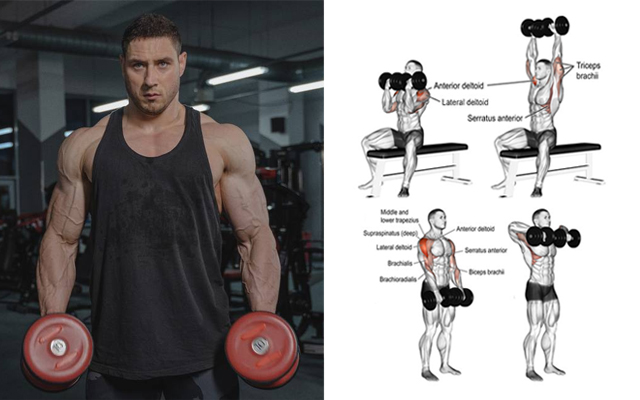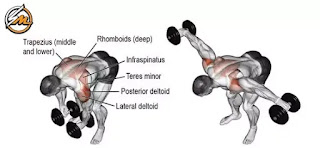There is no doubt that everyone looks beautiful with muscular shoulders. The definition around the shoulders is the ideal complement to a sleeveless shirt or dress and helps to accentuate a man or woman's figure.
Beyond just looking good, shoulder exercises also improve posture and develop the muscles that surround the shoulder joint, which results in a more stable and robust body structure. One of the most sensitive joints is the shoulder joint. Consider executing arm circles to get an idea of how much range of motion is possible at the shoulder joint.
This movement may change if the muscles surrounding the shoulder joint are weak, leading to instability and frequent injury. Training the deltoid muscle (the visible muscle that surrounds the shoulder) and the rotator cuff (muscles that stabilize the shoulder) is necessary to prevent injuries to the shoulders. The shoulder joint features a number of important stabilizers that function to maintain the shoulder's motion and allow for improved definition around the shoulder. By strengthening the rotator cuff muscles (subscapularis, supraspinatus, infraspinatus, and teres minor), you can prevent injuries by stabilizing the shoulder joint.
Benefits of Shoulder Exercises
Shoulder exercises offer numerous benefits for overall health, fitness, and functional movement. Here are some key advantages of incorporating shoulder exercises into your fitness routine:
Increased Shoulder Strength: Shoulder exercises target the muscles around the shoulders, including the deltoids, rotator cuffs, and upper back muscles. Regularly performing these exercises can enhance shoulder strength, making daily activities easier and reducing the risk of injury.
Improved Posture: Strong and well-developed shoulder muscles contribute to better posture. By strengthening the muscles of the upper back and shoulders, you can counteract the effects of slouching or rounded shoulders, promoting an upright and aligned posture.
Enhanced Upper Body Functionality: The shoulders play a critical role in various upper body movements, such as pushing, pulling, lifting, throwing, and reaching. Strong and stable shoulders improve performance in sports, weightlifting, and daily functional activities.
Injury Prevention: Shoulder exercises help strengthen the rotator cuff muscles, which stabilize the shoulder joint. A strong rotator cuff can reduce the risk of shoulder injuries, including strains, impingements, and dislocations.
Increased Range of Motion and Flexibility: Regular shoulder exercises can improve shoulder joint mobility and flexibility. This is particularly beneficial for individuals with tight or stiff shoulders, helping to increase the range of motion and alleviate discomfort.
Balanced Muscular Development: Properly targeted shoulder exercises can contribute to balanced muscular development throughout the upper body, preventing muscle imbalances and reducing the risk of overuse injuries.
Aesthetic Benefits: Well-developed shoulders contribute to an aesthetically pleasing physique. Toned and defined shoulder muscles can enhance the appearance of the upper body and create a more symmetrical and balanced look.
Functional Stability: Strong shoulders provide stability to the entire upper body and serve as a solid foundation for other exercises and movements. Strengthening the shoulder muscles can improve stability during exercises like bench presses, push-ups, and overhead lifts.
Remember to always use proper form and technique when performing shoulder exercises to maximize the benefits and minimize the risk of injury. If you have any underlying shoulder issues or concerns, it's advisable to consult with a healthcare professional or a qualified fitness trainer before starting a new exercise routine.
7 Best Shoulder Exercises for Building Muscle
Dumbbells are versatile and efficient tools for targeting your shoulder muscles. Here are eight effective dumbbell shoulder exercises:
Dumbbell Shoulder Press
Sit or stand with dumbbells in hand at shoulder level, palms facing forward. Push the dumbbells up overhead until your arms are fully extended. Lower them back to the starting position with control.
Dumbbell Lateral Raise
Stand with dumbbells by your sides, palms facing inward. Keeping a slight bend in your elbows, raise the dumbbells out to the sides until they reach shoulder height. Slowly lower them back down.
Dumbbell Front Raise
Stand with dumbbells in front of your thighs, palms facing your body. Lift the dumbbells straight out in front of you, keeping your arms extended, until they reach shoulder height. Lower them back down slowly.
Dumbbell Rear Delt Fly
Bend forward at the hips while holding dumbbells, palms facing each other. Keep your back flat and slightly bent knees. Lift the dumbbells out to the sides, squeezing your shoulder blades together. Lower the weights back down.
Arnold Press
Start with dumbbells at shoulder level, palms facing your body. As you press the dumbbells upward, rotate your palms outward, so they face forward at the top of the movement. Reverse the motion on the way down.
Dumbbell Shrugs
Hold dumbbells at your sides, palms facing your body. Elevate your shoulders toward your ears as high as possible, hold for a brief moment, then lower them back down.
Dumbbell Upright Row
Begin with dumbbells in front of your thighs, palms facing your body. Pull the dumbbells upward, leading with your elbows until they reach chest level. Lower them back down under control.
Remember to choose weights that challenge you but still allow for proper form and control. Perform these exercises with the correct technique, maintain good posture, and gradually increase the weight as your strength improves.













.jpg)
0 Comments